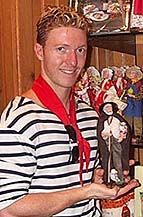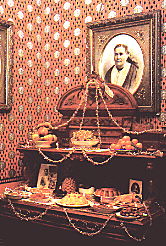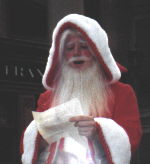CHRISTMAS
in
FRANCE
by
Bill Egan,
Christmas Historian
|
 In 15th century France, the solemn Christmas melodies, sung in Latin, began to take on a new form. This form was sung in local dialects, often to the tunes of popular songs. They were included in the rural shepherds' plays, the pastorales. They were sung as key parts of the scene and also as transitions from one scene to another. The most famous of all French carols Minuit, Chretiens!, or "Oh, Holy Night" was writtem im 1847. Today, all over France, church congregations traditionally sing the carol at the stroke of midnight on Christmas Eve. In 15th century France, the solemn Christmas melodies, sung in Latin, began to take on a new form. This form was sung in local dialects, often to the tunes of popular songs. They were included in the rural shepherds' plays, the pastorales. They were sung as key parts of the scene and also as transitions from one scene to another. The most famous of all French carols Minuit, Chretiens!, or "Oh, Holy Night" was writtem im 1847. Today, all over France, church congregations traditionally sing the carol at the stroke of midnight on Christmas Eve.
 Nearly every French home at Christmastime displays a Nativity scene or creche, which serves as the focus for the Christmas celebration. The creche is often peopled with little clay figures called santons or "little saints." An extensive tradition has evolved around these little figures which are made by craftsmen in the south of France throughout the year. In addition to the usual Holy Family, shepherds, and Magi, the craftsmen also produce figures in the form of local dignitaries and characters. The craftsmanship involved in creating the brightly colored santons is quite astounding and the molds have been passed from generation to generation for several centuries. Throughout December the figures are sold at annual Christmas fairs in Marseille and Aix. Nearly every French home at Christmastime displays a Nativity scene or creche, which serves as the focus for the Christmas celebration. The creche is often peopled with little clay figures called santons or "little saints." An extensive tradition has evolved around these little figures which are made by craftsmen in the south of France throughout the year. In addition to the usual Holy Family, shepherds, and Magi, the craftsmen also produce figures in the form of local dignitaries and characters. The craftsmanship involved in creating the brightly colored santons is quite astounding and the molds have been passed from generation to generation for several centuries. Throughout December the figures are sold at annual Christmas fairs in Marseille and Aix.
The Christmas tree has never been particularly popular in France, and though the use of the Yule log has faded, the French make a traditional Yule log-shaped cake called the Buche de Noel, which means "Christmas Log." The cake, among other food in great abundance is served at reveillon, the grand feast of the season.
 Le reveillon is a very late supper held after midnight mass on Christmas Eve. The menu for the meal varies according to regional culinary tradition. In Alsace, goose is the main course, in Burgundy it's turkey with chestnuts, and the Parisians feast upon oysters, lobster, and pate de foie gras (often carved in the shape of a Yule log). It is traditional in Provence to cap the reveillon with thirteen desserts as seen here on the sideboard. This is an ancient custom, symbolizing Christ and the twelve apostles. Le reveillon is a very late supper held after midnight mass on Christmas Eve. The menu for the meal varies according to regional culinary tradition. In Alsace, goose is the main course, in Burgundy it's turkey with chestnuts, and the Parisians feast upon oysters, lobster, and pate de foie gras (often carved in the shape of a Yule log). It is traditional in Provence to cap the reveillon with thirteen desserts as seen here on the sideboard. This is an ancient custom, symbolizing Christ and the twelve apostles.
 French children receive gifts from Pere Noel who wears wooden shoes and carries his Christmas gifts in a basket strapped to his back. He arrives with his donkey and leaves the animal outside the house while he goes down the chimney with his gifts for children who have behaved. Generally adults wait until New Year's Day to exchange gifts. French children receive gifts from Pere Noel who wears wooden shoes and carries his Christmas gifts in a basket strapped to his back. He arrives with his donkey and leaves the animal outside the house while he goes down the chimney with his gifts for children who have behaved. Generally adults wait until New Year's Day to exchange gifts.

Song: Bring a Torch Jeanette, Isabella
© 1999-2002 by W. C. Egan
|